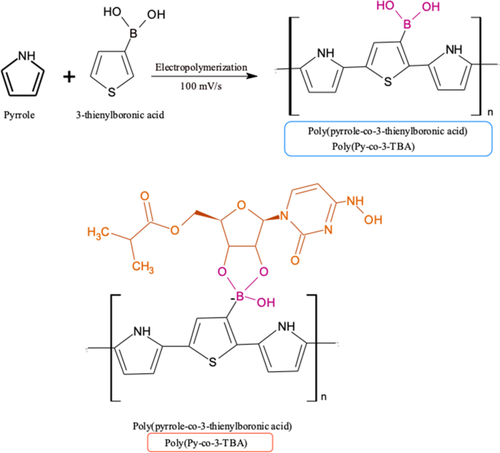Microchimica Acta ( IF 5.7 ) Pub Date : 2024-04-17 , DOI: 10.1007/s00604-024-06353-w Ahmet Cetinkaya , M. Altay Unal , Hasan Nazır , M. Emin Çorman , Lokman Uzun , Sibel A. Ozkan

|
A comparative analysis of molecularly imprinted polymers based on different synthesis techniques was performed for the recognition of molnupiravir (MOL). The polymerizations were performed with 3-thienyl boronic acid (3-TBA) as a functional monomer by electropolymerization (EP) and with guanine methacrylate (GuaM) as a functional monomer by photopolymerization (PP). Morphological and electrochemical characterizations of the developed sensors were investigated to verify the constructed sensors. Moreover, quantum chemical calculations were used to evaluate changes on the electrode surface at the molecular and electronic levels. The dynamic linear range of both designed sensors under optimized experimental conditions was found to be 7.5 × 10−12–2.5 × 10−10 M and 7.5 × 10−13–2.5 × 10−11 M for EP and PP, respectively. The effect of various interfering agents on MOL peak current was assessed for the selectivity of the study. In the presence of 100 times more interfering agents, the RSD and recovery values were determined. The RSD values of GuaM/MOL@MIP/GCE and poly(Py-co-3-PBA)/MOL@MIP/GCE sensors were found to be 1.99% and 1.72%, respectively. Furthermore, the recovery values of the MIP-based sensors were 98.18–102.69% and 98.05–103.72%, respectively. In addition, the relative selectivity coefficient (k′) of the proposed sensor was evaluated, and it exhibited good selectivity for MOL with respect to the NIP sensor. The prepared sensor was successfully applied to determine MOL in commercial serum samples and capsule form. In conclusion, the developed sensors provided excellent reproducibility, repeatability, high sensitivity, and selectivity against the MOL molecule.
Graphical Abstract
中文翻译:

电聚合和光聚合测定莫努匹拉韦的比较研究及其通过计算设计的分子印迹聚合物在电化学传感器中的应用
对基于不同合成技术的分子印迹聚合物进行了比较分析,以识别莫努匹拉韦(MOL)。以3-噻吩基硼酸(3-TBA)为功能单体,通过电聚合(EP)进行聚合;以甲基丙烯酸鸟嘌呤(GuaM)为功能单体,通过光聚合(PP)进行聚合。研究了所开发的传感器的形态和电化学特征,以验证所构建的传感器。此外,量子化学计算用于评估电极表面在分子和电子水平上的变化。在优化实验条件下 ,EP和PP的两种设计传感器的动态线性范围分别为7.5 × 10 -12 –2.5 × 10 -10 M和7.5 × 10 -13 –2.5 × 10 -11 M。为了研究的选择性,评估了各种干扰剂对 MOL 峰值电流的影响。在存在 100 倍以上干扰剂的情况下,测定 RSD 和回收率值。 GuaM/MOL@MIP/GCE 和 poly(Py-co-3-PBA)/MOL@MIP/GCE 传感器的 RSD 值分别为 1.99% 和 1.72%。此外,基于 MIP 的传感器的回收率分别为 98.18-102.69% 和 98.05-103.72%。此外,还评估了所提出的传感器的相对选择性系数(k '),相对于NIP传感器,它对MOL表现出良好的选择性。所制备的传感器成功应用于测定商业血清样品和胶囊形式中的 MOL。总之,所开发的传感器具有出色的再现性、重复性、高灵敏度和对 MOL 分子的选择性。



























 京公网安备 11010802027423号
京公网安备 11010802027423号